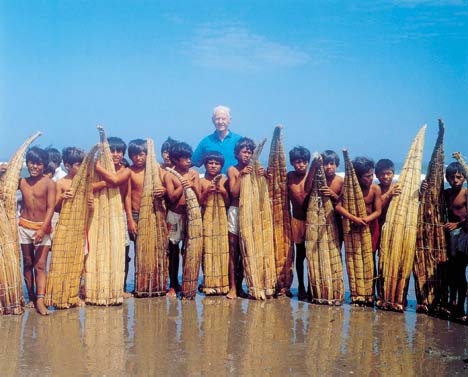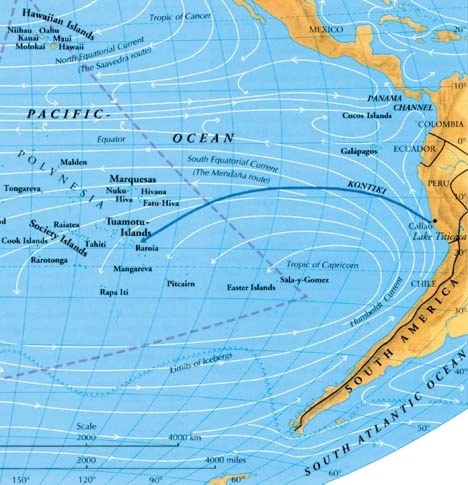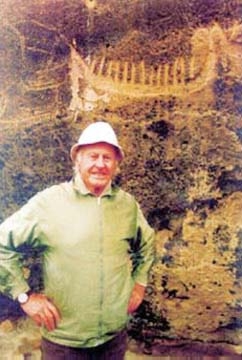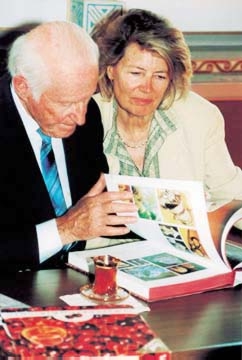|

Summer 2000 (8.2)
Pages
78-83
Scandinavian
Ancestry
Tracing
Roots to Azerbaijan
by Thor Heyerdahl

Above: Thor Heyerdahl with
Peruvian children who still construct traditional boats made
of reeds, the principle material that enabled early migrations
on trans-oceanic voyages. Courtesy: Thor Heyerdahl.
Other
Articles related to Thor Heyerdahl in Azerbaijan International
Magazine
(1) Thor Heyerdahl
in Azerbaijan: KON-TIKI
Man
by Betty Blair (AI 3:1, Spring 1995)
(2) The Azerbaijan Connection: Challenging
Euro-Centric Theories of Migration by Heyerdahl (AI 3:1, Spring 1995)
(3) Azerbaijan's
Primal Music Norwegians Find 'The Land We Come From' by Steinar Opheim (AI
5.4, Winter 1997)
(4) Thor
Heyerdahl in Baku
(AI 7:3, Autumn 1999)
(5) Quote:
Earlier Civilizations - More Advanced - Thor Heyerdahl (AI 8.3, Autumn 2000)
(6) The
Kish Church - Digging Up History - An Interview with J. Bjornar Storfjel
(AI 8.4, Winter 2000)
(7) Adventurer's
Death Touches Russia's Soul - Constantine Pleshakov (AI 10.2,
Summer 2002)
(8) Reflections
on Life - Thor Heyerdahl (AI 10.2, Summer 2002)
(9) First
Encounters in the Soviet Union - Thor Heyerdahl (AI 10.2,
Summer 2002)
(10) Thor
Heyerdahl's Final Projects - Bjornar Storfjell (AI 10.2,
Summer 2002)
(11) Voices
of the Ancients: Rare Caucasus Albanian Text - Dr. Zaza Alexidze
(AI 10.2, Summer 2002)
(12) Heyerdahl
Burns "Tigris" Reed Ship to Protest War - Letter
to UN - Bjornar Storfjell, Blair (AI 11.1Winter 2003)
Archeologist and historian Thor Heyerdahl, 85, has visited Azerbaijan
on several occasions during the past two decades. Each time,
he garners more evidence to prove his tantalizing theory - that
Scandinavian ancestry can be traced to the region now known as
Azerbaijan.
Heyerdahl first began forming this hypothesis after visiting
Gobustan, an ancient cave dwelling found 30 miles west of Baku,
which is famous for its rock carvings. The sketches of sickle-shaped
boats carved into these rocks closely resemble rock carvings
found in his own native Norway.

Above: Determined to prove
that early man could have crossed the ocean in reed boats, Thor
Heyerdahl sailed a reed boat named Ra 2 for 3,270 sea miles (6,100
kilometers) in 57 days in 1970. Courtesy: Thor Heyerdahl
Years later, the explorer stumbled upon another correlation between
Norway and Azerbaijan. Norwegian mythology tells that the Scandinavian
god Odin moved with his people to Norway from a land called Aser,
in order to avoid Roman occupation. A 13th-century historian's
description of Aser's origination matches that of Azerbaijan:
east of the Caucasus mountains and the Black Sea.
Is this story mythology or history? During his most recent visit
to Azerbaijan in May 1999, Heyerdahl elaborated his point of
view at a public forum. Here is his speech with personal notations
added by Heyerdahl himself just prior to our going to press.

Above: Heyerdahl's route that
he made with a balsa wood raft Kon-Tiki in 1947 to prove that
early transoceanic migrations were possible. Source: "Thor
Heyerdahl, the Explorer", Oslo: J.M. Stenersens Forlag,
1994.
_____
I think as science advances, it will become more and more evident
that we have more in common with each other than any of us realized
a few decades ago. This afternoon I visited the Gobustan caves.
From the first time I saw the carvings out there [several years
ago], I was attracted to the petroglyphs that feature reed ships.
On the way back from Gobustan, I was told that I was supposed
to speak tonight. I was told that I should speak about my relationship
with Azerbaijan and how it began. I had barely half an hour to
prepare myself for this topic, but I hope you will give me half
an hour so I can tell you what I've been thinking.
The first time I came to Azerbaijan was in 1981 [He also visited
in 1994, 1997 and 1999]. There weren't very many visitors from
outside the Iron Curtain who came here back in those days. My
invitation came from Azerbaijan's Academy of Sciences. I started
thinking about why the Academy of Sciences in Azerbaijan would
invite me and it dawned on me that I was in a very unique situation
at the time because I was both a member of the New York Academy
of Sciences and had received an Honorary Doctorate from the Soviet
Academy of Sciences. I didn't believe in barriers between nations.
I believed in people, not political parties.

Above:
In the ancient
caves of Gobustan which date back at least 5,000 years, cave
drawings depict two different kinds of boats that were used for
early navigation. Heyerdahl is convinced that people living in
the area now known as Azerbaijan settled in Scandinavia around
100 AD. Gobustan is located about 30 miles southwest of Baku.
At that time I was fighting with scientists all over the world
- both in the East and the West - because I believed that there
had been peaceful contact between nations much longer than we,
who consider ourselves civilized, ever realized. I believe there
was contact by ships along the rivers and oceans long before
civilization began. Earlier this century, nobody believed that
people could navigate with the kinds of vessels that men were
using 5,000 years ago. So I was fighting with scientists from
all over the world - on both sides of the Iron Curtain - for
my theory of ocean migration. I spent most of my time answering
attacks in scientific publications. I had friends in Russia who
sent me translations of these attacks. I answered back and my
defense was published in Russian. Of course, it took quite a
bit of time.

Above: Roman inscription at
Gobustan indicating that Roman troops were in the region around
97 AD.
One day I received a very surprising letter from Professor Keldish,
President of the Soviet Academy of Sciences in Moscow. He was
quite famous on both sides of the Iron Curtain as he had sent
the first Sputnik into space. He invited me to come to Moscow
and defend my own theory in front of the Soviet scientists. I
accepted the invitation and went alone to Moscow. It was a great
moment for me to address the entire Academy, in a part of the
world that was not very popular in my part of the world at that
time.
  President
Keldish himself organized the questions and it was a very fair
and honest discussion. Before I left, I was given an Honorary
Doctor's Degree from Lomonosov University in Moscow. Doctor Keldish
asked me: "Why don't you collaborate with Russia and people
from the Soviet part of the world in some of your expeditions
in the future?" President
Keldish himself organized the questions and it was a very fair
and honest discussion. Before I left, I was given an Honorary
Doctor's Degree from Lomonosov University in Moscow. Doctor Keldish
asked me: "Why don't you collaborate with Russia and people
from the Soviet part of the world in some of your expeditions
in the future?"
Left: Thor Heyerdahl in 1994
at the Gobustan caves in Azerbaijan. Courtesy: Statoil
Now let me explain my own background as a scientist, because
it wasn't everyone that President Keldish invited to come to
Moscow. The reason was boats like those carved on the cave walls
in Gobustan.
I had been educated in Oslo University in biology. As a student,
I went on an archeological expedition to an island in the middle
of the Pacific called Fatu-Hiva in Polynesia. I was to study
how life had arrived at this island, which had come straight
up from the bottom of the ocean. Millions of years ago the island
had just been boiling lava. But when the first European explorers
came, there were all sorts of plants and animals and even human
beings. Of course, the study of zoology includes human beings
as well. This was back in 1938.
It caused me to wonder: how did early people travel across the
ocean? Europeans never discovered a single uninhabited island
in any ocean. Every single island that could have been inhabited
already was. All the thousands of islands in the Pacific and
also all those in the Indian Ocean were populated. The islands
in the Atlantic - the Canary Islands and the Caribbean Islands
- were also populated. And so this is how I became interested
in early navigation.
Doubting the Historians
  Scientists
at that time insisted that no American Indian could have left
America before Columbus, and no people could have reached America
before Columbus except via the Bering Straits in the Arctic.
This is where I learned how important it is for scientists to
collaborate across different branches of science. I had my university
training in biology, geography and physical anthropology. I had
biological proof that someone must have brought certain plants
from South America to Polynesia - for instance, the sweet potato,
which only grew in South America. It could not have drifted alone
across the ocean without the help of man. Scientists
at that time insisted that no American Indian could have left
America before Columbus, and no people could have reached America
before Columbus except via the Bering Straits in the Arctic.
This is where I learned how important it is for scientists to
collaborate across different branches of science. I had my university
training in biology, geography and physical anthropology. I had
biological proof that someone must have brought certain plants
from South America to Polynesia - for instance, the sweet potato,
which only grew in South America. It could not have drifted alone
across the ocean without the help of man.
Left: Thor Heyerdahl and
wife Jacqueline Beers looking at book about antiquities in Azerbaijan
at the Academy of Science during their 1999 visit to Azerbaijan.
Courtesy: Statoil
Historians and anthropologists told me that in South America
they had only rafts before the Europeans came. And so that's
how I decided to construct a raft like I imagined the South American
Indians had done, and sail with friends from Peru to Polynesia.
This voyage on the "Kon Tiki" in 1947 was my first
experience with a small vessel on the open ocean. From then on,
I began organizing archeological excavations. My first was in
1952 to the Galapagos Islands. The next was to Easter Island
in 1955-56. That was the first time I saw carvings of those large
sickle-shaped ships. They were the same type as those in ancient
Egypt and Mesopotamia. I started to suspect that people of early
civilizations in North Africa might have been able to cross the
Atlantic long before Columbus did.
We Europeans usually think that we have discovered everything,
but that's not correct. We're realizing that everywhere there
were people who came before us. My anthropological training has
made me understand more and more how much alike people are, regardless
of nationality, race or physical features.
I've also come to the conclusion that we err if we believe that
we are much different from people who lived 5,000 years ago.
I think that we can say with assurance that we are born with
the same genes as people 5,000 years ago were. We start at zero
for each new generation. We accumulate technical knowledge, but
our intelligence or mental characteristics don't change.
With this in mind, I came to the conclusion that the Egyptians
who built the pyramids left behind art and technology of an incredibly
high level. They would not have continued to build boats made
of reeds if they had considered such vessels to be primitive
and ineffective. So, I decided that there must be something wrong
with our scientific theories. All the literature that I had read
at the university had said that boats made of balsam wood would
absorb water and sink.
So I went on to prove that these scientific theories were wrong.
The Kon Tiki raft kept afloat for 101 days until we arrived in
Polynesia. In Egypt it was said at the Papyrus Institute that
papyrus reed would absorb water and sink after two weeks. Again,
I decided to trust the ancient pharaohs more than modern scientists
who have never even seen a papyrus ship. That's how I came to
build my first reed boat. Together, with an international crew
of seven people, we sailed for two months. The reed boat was
still afloat.
The Buduma fishermen from Lake Chad in Central Africa, who built
this reed ship, were not used to ocean waves. The rope lashings
busted and we started losing reeds. The problem was that half
of the reeds were not floating with the rest of the ship. We
were sitting there watching the reeds float behind us. When we
arrived off the coast of the U.S., I decided that we should not
take any risks with human life, but we should try again. For
one month we had been swimming underneath the vessel and trying
to tie it back together with ropes. In the end we had 17 sharks
swimming alongside us, so we had to discontinue our repairs.
So I told my men, "Are you going to come? We'll start again
next year."
So we attempted to make the trip again and crossed the Atlantic
from Morocco to Barbados in 1970, with the papyrus ship Ra II
and with all the same crew, plus a Japanese cameraman.
On both these Atlantic trips, I experimented not only with the
vessel, but also with the crew. I mixed people - black as black
as you can get, with yellow and white - along with representatives
of all the existing main religions, including atheism. There
was one person from North America and one from Soviet Russia,
one Arab and one Jew.
We lived together so well that they all came with me again when
I sailed another reed ship in the Indian Ocean in 1977-78. That
reed ship, the Tigris, was larger, which made room for more nationalities.
We sailed down the river Tigris up to the Persian Gulf, up to
Pakistan, the Indus Valley, then reversed our direction and sailed
across the Indian Ocean and came back to the entrance of the
Red Sea, where we could meet the modern world. The 11 of us were
from 11 nations, from all different political inclinations, all
major religions, and we all lived together in peace for five
months in the tight quarters of a reed ship.
We received messages from the United Nations that we shouldn't
push any further because there was a war being waged on both
sides of the Red Sea, where millennia ago peaceful Sumerians
and the people from the Indus Valley had traded with Egyptians.
We sent a telegram to the United Nations and recommended that
they halt weapons delivery to people who had been fighting only
with swords until Westerners had come and were making profit
from perpetrating wars more catastrophic than ever.
Visiting Azerbaijan
And so, after those three expeditions on three different oceans,
I was invited to visit Azerbaijan. I came here because I had
established good contacts with scientists in this country, and
I had learned that you had something quite sensational at Gobustan.
I came to Azerbaijan as a guest of the Academy of Sciences in
Azerbaijan to see the petroglyphs in Gobustan.
The President of the Academy was driving around with me to see
this country and its beautiful nature and to meet local people
- scientists as well as farmers. I learned about his family connections
the day before I left - he was the brother of the President of
Azerbaijan. That's how my friendship with your country started.
Due to this friendship that I have with Azerbaijan, when Statoil
from Norway came here, I was invited to join the delegation because
I knew so many people here. And that's when I became interested
in the fact that you have two types of boat petroglyphs in Gobustan.
On my first visit, I came to study the reed ships that are similar
to the boats of the ancient Mediterranean. But on my second visit,
I learned that the people in Azerbaijan call themselves Azeri.
I remembered from my school days that we have legends in Norway
woven into Norwegian history in such an intricate way that we
don't know where history starts and mythology ends. But the documented
history of Norway dates back more than 800 years. Traditions
about the original homeland of our ancestors were recorded in
the 18th century in Ireland and say that we are descendants of
the land of the Aser.
Early Scandinavian
History
We learn of the line of royal families in Denmark, Sweden and
Norway. But we didn't take these stories about our beginnings
seriously because they were so ancient. We thought it was just
imagination, just mythology. The actual years for the lineage
of historic kings began around the year 800 AD. So we learned
all the kings in the 1,000 years that followed and did not interest
ourselves in earlier names.
But I remember from my childhood that the mythology started with
the god named Odin. From Odin it took 31 generations to reach
the first historic king. The record of Odin says that he came
to Northern Europe from the land of Aser. I started reading these
pages again and saw that this was not mythology at all, but actual
history and geography.
Snorre, who recorded these stories, started by describing Europe,
Asia and Africa, all with their correct names, Gibraltar and
the Mediterranean Sea with their old Norse names, the Black Sea
with the names we use today again, and the river Don with its
old Greek name, Tanais. So, I realized that this has nothing
to do with the gods who lived with the Thunder god Thor among
the clouds.
Snorre said that the homeland of the Asers was east of the Black
Sea. He said this was the land that chief Odin had, a big country.
He gave the exact description: it was east of the Black Sea,
south of a large mountain range on the border between Europe
and Asia, and extended southward towards the land of the Turks.
This had nothing to do with mythology, it was on this planet,
on Earth.
Then came the most significant point. Snorre says: "At that
time when Odin lived, the Romans were conquering far and wide
in the region. When Odin learned that they were coming towards
the land of Asers, he decided that it was best for him to take
his priests, chiefs and some of his people and move to the Northern
part of Europe."
The Romans are human beings, they are from this planet, they
are not mythical figures. Then I remember that when I came to
Gobustan, I had seen a stone slab with Roman inscriptions. I
contacted the Academy of Sciences of Azerbaijan. I was taken
to the place, and I got the exact wording of the inscription.
There's a very logical way of figuring out when this was written.
It had to be written after the year 84 AD and before the year
97 AD. If this inscription matched Snorre's record, it would
mean that Odin left for Scandinavia during the second half of
the 1st century AD. Then I counted the members of the generations
of kings, every king up to the grandfather of the king that united
Norway into one kingdom, because such information is available
- around 830 AD.
In anthropology we reckon 25 years per generation for ruling
kings. In modern times, a generation may extend up to 30 years,
but on average the length of a generation in early reigns is
25 years. When you multiply 31 generations by 25 years, you come
exactly back to the second half of the 1st century AD. So there
is proof that these inscriptions carved by the Romans in stone
coincide with the written history written almost 1,800 years
ago in Iceland.
We all know that the Northern people are called Caucasian. Here
is where history, archeology, geography and physical anthropology
come together.
The more I research the topic, the more evidence I find that
this part of the planet has played a much more significant role
than anybody ever suspected. I am working on a book at present
together with a colleague, and we are halfway through it describing
our observations.
Blond-Haired Mummies
In the meantime we have contacts with the Academies of Sciences
in 11 nations. We do not want to leave anything out. The most
surprising discovery was when we contacted Communist China. They
had discovered blond-haired mummies in the Karim Desert deep
inside China, so perfectly preserved in the cold climate and
salty earth that you could see the color of the skin and hair.
The Chinese archeologists were surprised because these mummies
were not Mongoloids at all; they suspected instead that they
were Vikings.
But it didn't make sense to me that Vikings should be deep inside
the deserts of China. When the Chinese archeologists conducted
radio-carbon dating, they determined that the mummies were of
Nordic type dating from 1,800 to 1,500 years BC. But the Viking
period started around 800 AD. It then became obvious that these
mummies were not Vikings who had come to China. Here was a missing
link. And again the Caucasus enters into the picture as a mutual
migratory center.
But this is not the end of the story. These mummies were dressed
in cloth that had been woven, and the colors and the woven pattern
were of a very specific type. The Chinese themselves studied
the mummies and then invited American experts to study the clothing
who determined that the weave and coloring were typical of the
Celts of Ireland. But this made no sense at all. Then we contacted
Ireland to get their sagas, and their written saga says that
their ancestors were Scythians. So, again, their roots come back
here to the Caucasus.
This is only the beginning, because this is as far as we have
obtained documentation from the Academies of Sciences with which
we are in contact. I will not go into detail further, but I have
also found archeological evidence that is so striking that there
can no longer be any doubt.
My conclusion is that Azerbaijan has been a very important center,
sending people in many directions and attracting people from
many directions. You have had metals that made the Romans want
to come here. But you have been very central in the evolution
of civilization, and more than anything, this is proven by the
petroglyphs in Gobustan.
One thing is clear: navigation occurred before civilization.
We used to believe that civilization came first, and once people
had developed a high enough level of civilization, then they
started to build boats. This just isn't true. On the contrary,
it was when people built ocean-going vessels - that enabled them
to contact each other so that they could trade and learn from
each other. It was through contact and peaceful cooperation that
civilization developed.
From Azerbaijan
International
(8.2) Summer 2000.
© Azerbaijan International 2000. All rights reserved.
Back to Index
AI 8.2 (Summer 2000)
AI Home
| Magazine Choice | Topics
| Store
| Contact
us
|